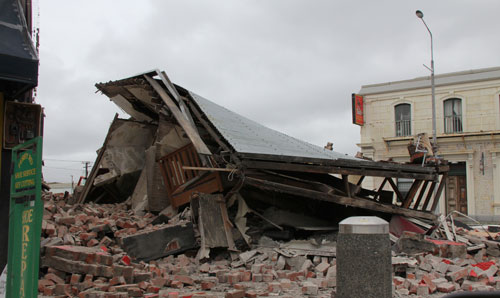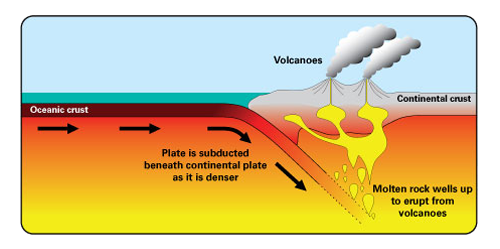Tohoku, Japan earthquake FAQs | 9.0 | 11 March 2011
How big was the earthquake and why did the magnitude change?
The earthquake had a magnitude of 9.0. This makes it the equal fifth largest earthquake ever recorded and the largest in Japan, since records began.
The largest earthquake in the world was in Chile in 1960, magnitude 9.5, which was five times bigger than the Tohoku earthquake.
Magnitudes are recalculated as more data becomes available; this resulted in the magnitude increasing from 8.9 to 9.0.
Why did it happen?
Earthquakes are caused by motion of the Earth's tectonic plates.
Honshu lies at the boundary between two of these plates. As they move past each other energy is released in the form of earthquakes.
East of Honshu, the Pacific plate is moving west at around 8–9 cm/year and is being pushed down, or subducted, underneath Honshu at the Japan Trench.
Which plates were involved?
Northern Honshu lies on the Okhotsk Plate.
The oceanic Pacific plate is being subducted under the Okhotsk plate along the line of the Japan Trench.
South of Tokyo, Honshu lies on the Amur plate. To the east, the Phillipines oceanic plate is being subducted under Southern Japan along the line of the Nankai trench.
Did Japan move?
GPS data from the Geospatial Information Authority (GSI) of Japan shows that the north-east coast of Japan moved east by up to 4 metres. The coast of north-east Japan moved eastward up to 4 metres, At the same time, the coastline subsided by about 0.5 metres.
Why was the earthquake 11 000 (or 8000) times larger than the Christchurch earthquake?
For each unit increase in magnitude, the energy released by an earthquake increases by a factor of around 32. Thus the difference between a magnitude 5 quake and a magnitude 7 is approximately 1000 (32(7-5) or 322).
In, this particular case, the magnitudes of the Tohoku and Christchurch earthquakes were 9.0 and 6.3 respectively, giving an energy difference of 11600 (32(9.0-6.3) or 322.7).
Using the initial magnitude of 8.9 gives a difference of 8000.
How long did the earthquake last?
It took just over two minutes for most of the 500–km fault to rupture.
However, the shaking experienced at greater distances from the epicentre would have lasted longer as the vibrations or seismic waves spread out.
Did the Earth 'wobble' on its axis?
The earth is not a perfect sphere, and its axis of rotation does not correspond to its axis of symmetry. As a result, the Earth precesses about its axis of rotation like a spinning top.
If the Earth was totally rigid, then this motion would be stable. However the earth is not rigid and movements of its constituent parts, including the atmosphere and oceans, occur.
These effects introduce a wobble (a movement of the Earth's axis), which is small but detectable. This is known as the Chandler Wobble.
A small wobble will can be caused as a result of great earthquakes like the recent event in Japan, due to the movement of mass close to the earth's surface, but it will only be marginally detectable by the most sensitive instruments and is not a cause for concern.
Likewise, the rate of rotation of the earth will have changed so that the length of day has changed by a few microseconds, but again this effect is too small to be easily observed, and it is not a permanent effect as it will be smoothed out by subsequent changes, for example, seasonal changes.
Was the earthquake caused by global warming?
There is no evidence that earthquakes are caused by global warming. Earthquake activity rates have remained roughly stable over many years.
Is the number of earthquakes increasing?
There is no evidence that the number of earthquakes is increasing.
See also Is earthquake activity increasing?
Could this ever happen in the UK?
No. Huge mega-thrust earthquakes like this only happen at plate boundary subduction zones where one of the Earth's tectonic plates is being pushed down, or subducted, beneath another.
Places where this happens include Japan, Sumatra and South America all of which have had earthquakes of magnitude 8.5 or greater in the last few years that have resulted in tsunami.
See also Could a Tsunami hit the British Isles?
How does the energy released compare to an explosion?
The amount of energy released by a magnitude 9 earthquake is roughly equivalent to 32 gigatons of TNT.
Contact
Contact Brian Baptie for further information

- A Comparison of the Folkestone and Market Rasen Earthquakes
- Revised Seismic Hazard Maps for the UK
- Seismogenesis and State of Stress in the UK
- Monitoring Volcanic Eruptions Using Interferometry
- Particular events
- Are yesterday's earthquakes tomorrow's disasters?
- Creating 'virtual seismometers' deep inside the Earth
- Fault line living
- Is earthquake activity related to the Moon or Sun?
- Is earthquake activity increasing?






